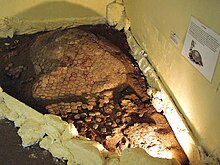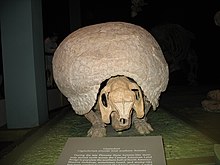Glyptotherium: Difference between revisions
m text |
removed citation needed claim, you cannot prove a negative. |
||
| Line 24: | Line 24: | ||
Like its living relative, the armadillo, ''Glyptotherium'' had a shell which covered its entire body, similar to a [[turtle]]. However, unlike a turtle's shell, the ''Glyptotherium'' shell was made up of hundreds of small six-sided scales. Some species grew up to six feet long and its armor weighed up to a ton. |
Like its living relative, the armadillo, ''Glyptotherium'' had a shell which covered its entire body, similar to a [[turtle]]. However, unlike a turtle's shell, the ''Glyptotherium'' shell was made up of hundreds of small six-sided scales. Some species grew up to six feet long and its armor weighed up to a ton. |
||
''Glyptotherium'' species thrived in tropical and [[subtropical]] regions of [[Florida]], [[South Carolina]], [[Texas]] to [[Arizona]]. There is no direct evidence of humans preying on the North American [[Glyptodon]]. |
''Glyptotherium'' species thrived in tropical and [[subtropical]] regions of [[Florida]], [[South Carolina]], [[Texas]] to [[Arizona]]. There is no direct evidence of humans preying on the North American [[Glyptodon]]. |
||
Glyptotherium was named by Osborn in 1903, assigned to [[Glyptodontinae]] by Downing and White in 1995 and to Glyptodontidae by Osborn (1903), Brown (1912), Carroll (1988), Cisneros (2005) and Mead et al. (2007). |
Glyptotherium was named by Osborn in 1903, assigned to [[Glyptodontinae]] by Downing and White in 1995 and to Glyptodontidae by Osborn (1903), Brown (1912), Carroll (1988), Cisneros (2005) and Mead et al. (2007). |
||
Revision as of 21:53, 3 May 2010
| Glyptotherium | |
|---|---|

| |
| Close-up of a nearly complete Glyptotherium texanum shell. | |
Fossil
| |
| Scientific classification | |
| Kingdom: | |
| Phylum: | |
| Class: | |
| Order: | |
| Family: | |
| Genus: | Glyptotherium
|
| |


Glyptotherium is an extinct genus of glyptodontid, a group of extinct mammals related to the armadillo living from 4.1—1.5 Ma (AEO). The genus is considered an example of North American megafauna, of which most have become extinct. Glyptotherium may have been wiped out by climate change or human interference.[1]
Like its living relative, the armadillo, Glyptotherium had a shell which covered its entire body, similar to a turtle. However, unlike a turtle's shell, the Glyptotherium shell was made up of hundreds of small six-sided scales. Some species grew up to six feet long and its armor weighed up to a ton.
Glyptotherium species thrived in tropical and subtropical regions of Florida, South Carolina, Texas to Arizona. There is no direct evidence of humans preying on the North American Glyptodon.
Glyptotherium was named by Osborn in 1903, assigned to Glyptodontinae by Downing and White in 1995 and to Glyptodontidae by Osborn (1903), Brown (1912), Carroll (1988), Cisneros (2005) and Mead et al. (2007).
See also
References
- "AMNH Bestiary". Retrieved 2006-06-18.
